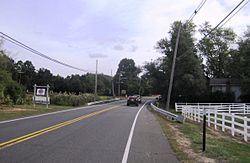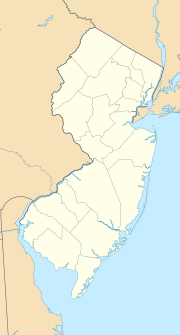Scobeyville, New Jersey facts for kids
Quick facts for kids
Scobeyville, New Jersey
|
|
|---|---|

Intersection of CR 537 and Laird Road
|
|
| Country | |
| State | |
| County | Monmouth |
| Township | Colts Neck |
| Named for | Scobey family |
| Elevation | 72 ft (22 m) |
| Time zone | UTC−05:00 (Eastern (EST)) |
| • Summer (DST) | UTC−04:00 (EDT) |
| ZIP Code |
07722
|
| GNIS feature ID | 880423 |
Scobeyville is a small, unincorporated community located in Colts Neck Township. This area is part of Monmouth County in the state of New Jersey. The community gets its name from the Scobey family, who have lived in the township since the 1700s. In the past, Scobeyville had a one-room schoolhouse, a post office, and a general store. It was also known for good fishing in the Yellow Brook.
Contents
Learning in Scobeyville
In 1820, the first schoolhouse in Scobeyville was built. It was located near County Route 537 and Hockhockson Road. Later, in 1851, a new school building replaced the old one. However, by 1916, this building was no longer considered good enough due to new state laws. It was stopped being used and unfortunately burned down in 1929.
Getting Around Scobeyville
In 1930, a bus route was started that connected Freehold and Red Bank. This bus line helped people in Scobeyville travel to many other places.
Local Businesses and Inventions
Scobeyville was home to several interesting businesses over the years.
Early Factories
A factory that made fanning mills was started by JHS Parke in Scobeyville. Fanning mills were machines used to separate grain from its husks. This factory closed before 1913, around the time a new machine called a harvesting machine was invented, which did a similar job more efficiently.
Wireless Communication
In 1928, a powerful Marconi wireless station was built in Scobeyville. This station was used mainly to send stock orders for places like Wall Street. It had a large concrete building and an antenna, costing a lot of money to build. It started working in March 1929. However, the company that owned it went out of business in 1930, and the station closed down.
Pen Manufacturing
In 1947, the building that used to house the wireless station was bought by the Stratford Pen Corporation. Before that, the building was used to make a type of apple brandy called Apple Jack. After 1947, it became a place for researching and developing ballpoint pens.
Canning Industry
A commercial canning factory began operating in 1862. The owner, Mr. Bucklin, was very creative and held many patents for machines that could automatically fill cans and cook food under pressure. The factory produced a brand called "My Choice" until 1943, when Mr. Bucklin retired. The canning plant was then sold to the Laird Corporation. They continued canning food to help with the "War Effort" until the end of the war, when the plant closed.
America's Oldest Distillery
Laird's Distillery, known as America's Oldest Distillery, is also located in Scobeyville.
Farming in Scobeyville
Scobeyville is well-known for its farms and agricultural products.
Fruit Orchards
In 1915, Frederick Lerch owned the largest fruit farm in Monmouth County, right in Scobeyville. It covered 100 acres and was completely dedicated to fruit trees. He was known to produce as many as 40,000 baskets of fruit from his orchard. Initially, he grew peach trees, but in 1917, he changed his entire orchard to apple trees. The area was also known for the Brook Turkey farm.
Applejack Production
William Laird also had an apple farm in Scobeyville. The cider made there was fermented into hard cider and applejack. The Laird family has operated an apple distillery in Scobeyville since the 1790s, stopping only during Prohibition and then starting again in 1933. The Laird family still runs an apple distillery in Scobeyville today. In 1937, Archduke Franz Josef Von Habsburg of Austria and his Duchess even visited the distillery during a special tour. Besides the Laird & Company distillery, much of the area today is still farmland and the Dorbrook Recreational Area. County Route 537 is the main road running east-west through Scobeyville, and Laird Road goes north from CR 537.
Chocolate Milk Production
Scobeyville was also where "Choc Corporation" produced chocolate milk. This was a separate business from the Laird applejack operation. The main office for Choc Corporation was in New York City, but the chocolate milk was made at the same cider mill that produced the applejack. This milk was advertised all over the country.
In 1932, the Laird Farm took legal action against another company that copied their special apple-shaped jug. Laird Farm had a patent for this unique design.
Crop Challenges
- In 1910, many farms in the area were badly affected by cutworms. These pests caused a lot of damage to cabbage and tomato plants.
- In 1937, Army worms also caused significant damage to crops that year.
Prohibition Enforcement
During Prohibition, when alcohol was illegal, there were several instances in Scobeyville where authorities found illegal alcohol operations.
- On January 22, 1931, federal agents and state police found 18 tons of sugar and 500 US gallons of alcohol at Shady Rest Farm. The barn was used to store and distribute these items for other illegal manufacturing nearby.
- In March 1931, federal agents discovered a large 75,000 US gallon still with a lot of mash at the Leon Hardy farm.
Mail Delivery Issues
In 1914, the Post Office officially stopped mail delivery to Scobeyville because there was no postmaster. This meant residents had to travel more than 5 miles to Eatontown to get their mail. After some discussion and help from Congressman Thomas J. Scully, the postal service set up a rural free delivery route for the residents. This meant mail was delivered directly to their homes again.




